BPM vs BPR: Advantages, Disadvantages, and Continuous Improvement
VerifiedAdded on 2023/01/18
|7
|1338
|48
Report
AI Summary
This report provides a comprehensive comparison between Business Process Management (BPM) and Business Process Reengineering (BPR), addressing their benefits and shortcomings, especially in the context of customer satisfaction, technology integration, and organizational changes. It delves into the phases of each approach, highlighting how BPR discards certain phases and the reasons behind this. Furthermore, the report explores how BPR and BPM can be synergistically combined within a company's long-term continuous improvement methodology. The report also includes a table answering questions related to BPMN (Business Process Model and Notation), detailing how to connect pools and elements within a BPMN diagram. Finally, a bibliography of relevant sources used in the report is provided.
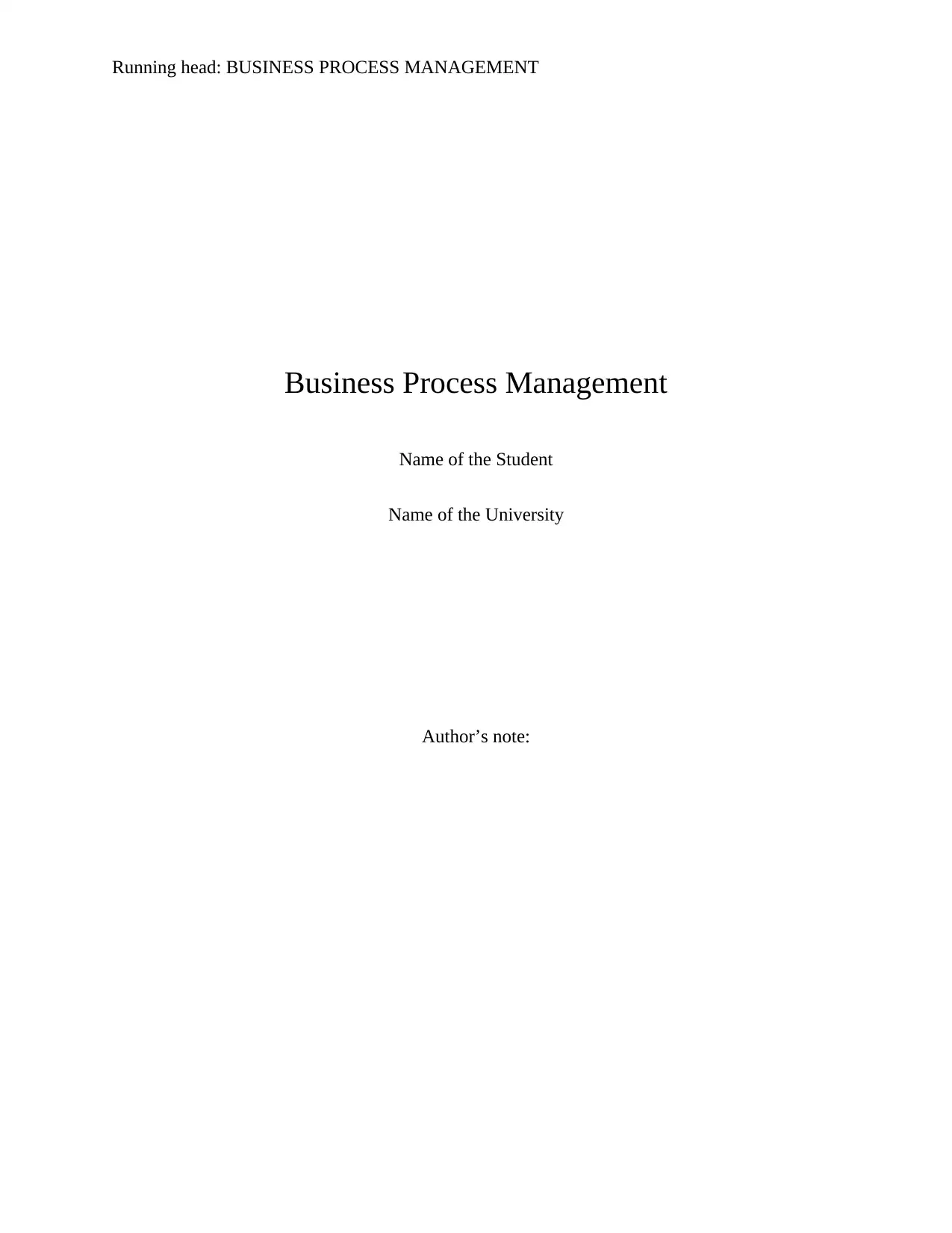
Running head: BUSINESS PROCESS MANAGEMENT
Business Process Management
Name of the Student
Name of the University
Author’s note:
Business Process Management
Name of the Student
Name of the University
Author’s note:
Paraphrase This Document
Need a fresh take? Get an instant paraphrase of this document with our AI Paraphraser
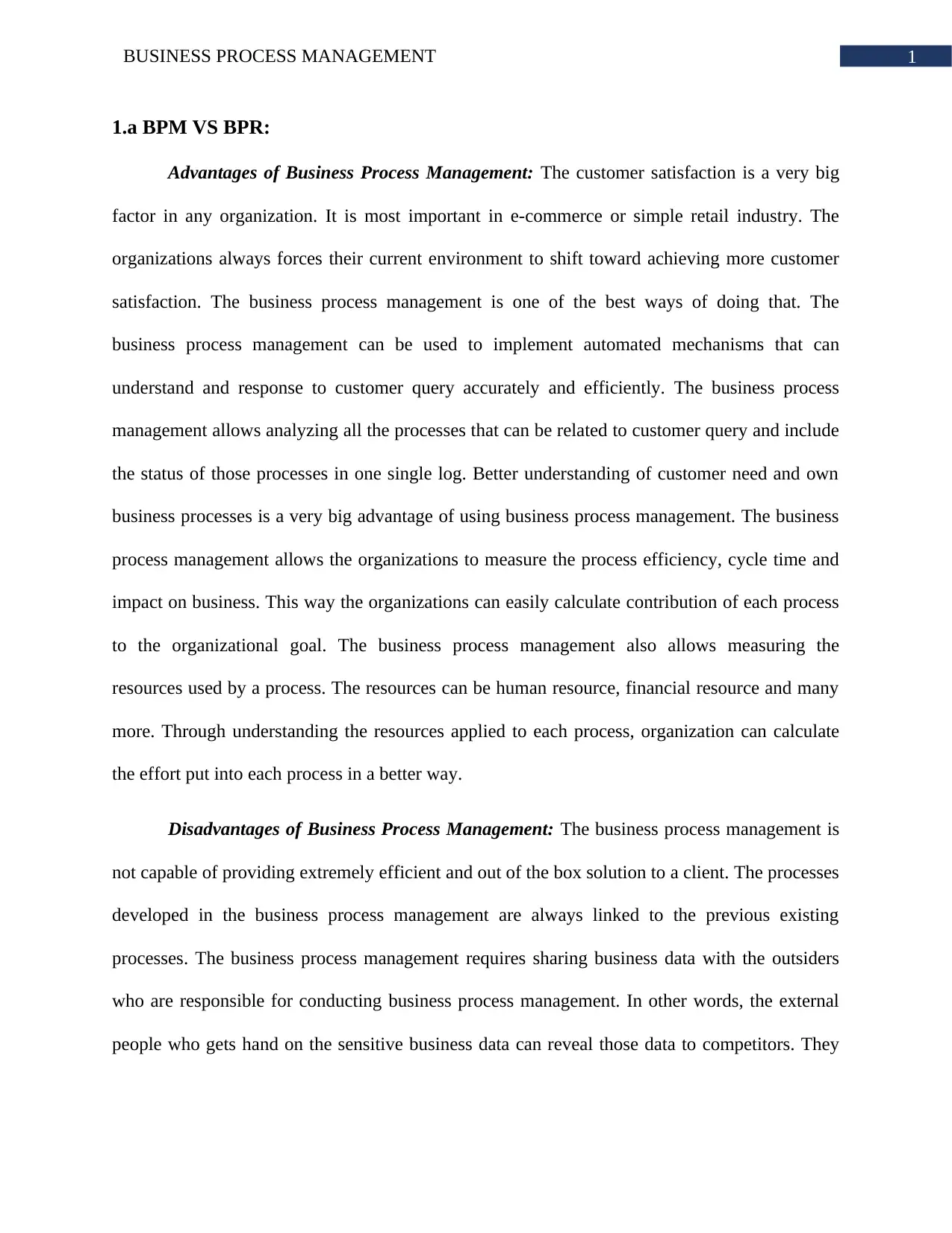
1BUSINESS PROCESS MANAGEMENT
1.a BPM VS BPR:
Advantages of Business Process Management: The customer satisfaction is a very big
factor in any organization. It is most important in e-commerce or simple retail industry. The
organizations always forces their current environment to shift toward achieving more customer
satisfaction. The business process management is one of the best ways of doing that. The
business process management can be used to implement automated mechanisms that can
understand and response to customer query accurately and efficiently. The business process
management allows analyzing all the processes that can be related to customer query and include
the status of those processes in one single log. Better understanding of customer need and own
business processes is a very big advantage of using business process management. The business
process management allows the organizations to measure the process efficiency, cycle time and
impact on business. This way the organizations can easily calculate contribution of each process
to the organizational goal. The business process management also allows measuring the
resources used by a process. The resources can be human resource, financial resource and many
more. Through understanding the resources applied to each process, organization can calculate
the effort put into each process in a better way.
Disadvantages of Business Process Management: The business process management is
not capable of providing extremely efficient and out of the box solution to a client. The processes
developed in the business process management are always linked to the previous existing
processes. The business process management requires sharing business data with the outsiders
who are responsible for conducting business process management. In other words, the external
people who gets hand on the sensitive business data can reveal those data to competitors. They
1.a BPM VS BPR:
Advantages of Business Process Management: The customer satisfaction is a very big
factor in any organization. It is most important in e-commerce or simple retail industry. The
organizations always forces their current environment to shift toward achieving more customer
satisfaction. The business process management is one of the best ways of doing that. The
business process management can be used to implement automated mechanisms that can
understand and response to customer query accurately and efficiently. The business process
management allows analyzing all the processes that can be related to customer query and include
the status of those processes in one single log. Better understanding of customer need and own
business processes is a very big advantage of using business process management. The business
process management allows the organizations to measure the process efficiency, cycle time and
impact on business. This way the organizations can easily calculate contribution of each process
to the organizational goal. The business process management also allows measuring the
resources used by a process. The resources can be human resource, financial resource and many
more. Through understanding the resources applied to each process, organization can calculate
the effort put into each process in a better way.
Disadvantages of Business Process Management: The business process management is
not capable of providing extremely efficient and out of the box solution to a client. The processes
developed in the business process management are always linked to the previous existing
processes. The business process management requires sharing business data with the outsiders
who are responsible for conducting business process management. In other words, the external
people who gets hand on the sensitive business data can reveal those data to competitors. They

2BUSINESS PROCESS MANAGEMENT
can also get involved in cybercrime to hack into the new system installed using business process
management.
Advantages of Business Process Reengineering: Technology integration is one of the
most influential advantage of business process reengineering. The business process
reengineering allows an organization to implement a new system or piece of technology from
scratch. The organization need not to have any kind of existing system upon whose processes the
new system functionality can be defined. The business process reengineering can be a lengthy
process that includes many organization changes, completed periodically for making the
organization more competitive. The business process reengineering is always done under
managerial supervision and periodical stakeholder meetings are must in the business process
reengineering checklist. Business process reengineering is a robust approach and always
welcome new changes in the scope. As the timeline of business process reengineering is long,
many new trends and technologies invented before business process reengineering is completed.
The business process reengineering allows a process to be developed from scratch. This allows
organizations to add new departments or whole new approach to business operations without
affecting the customer.
Disadvantages of Business Process Reengineering: The business process reengineering
drastically changes the existing organization environment and working patterns. Because of this
reason, a lot of resistance is experienced from employee side. Managing this resistance takes a
lot of time and effort of management. The number of risks associated with the business process
reengineering is too many. As the business process reengineering is lengthy approach, many
organizations lose their interest.
can also get involved in cybercrime to hack into the new system installed using business process
management.
Advantages of Business Process Reengineering: Technology integration is one of the
most influential advantage of business process reengineering. The business process
reengineering allows an organization to implement a new system or piece of technology from
scratch. The organization need not to have any kind of existing system upon whose processes the
new system functionality can be defined. The business process reengineering can be a lengthy
process that includes many organization changes, completed periodically for making the
organization more competitive. The business process reengineering is always done under
managerial supervision and periodical stakeholder meetings are must in the business process
reengineering checklist. Business process reengineering is a robust approach and always
welcome new changes in the scope. As the timeline of business process reengineering is long,
many new trends and technologies invented before business process reengineering is completed.
The business process reengineering allows a process to be developed from scratch. This allows
organizations to add new departments or whole new approach to business operations without
affecting the customer.
Disadvantages of Business Process Reengineering: The business process reengineering
drastically changes the existing organization environment and working patterns. Because of this
reason, a lot of resistance is experienced from employee side. Managing this resistance takes a
lot of time and effort of management. The number of risks associated with the business process
reengineering is too many. As the business process reengineering is lengthy approach, many
organizations lose their interest.
⊘ This is a preview!⊘
Do you want full access?
Subscribe today to unlock all pages.

Trusted by 1+ million students worldwide
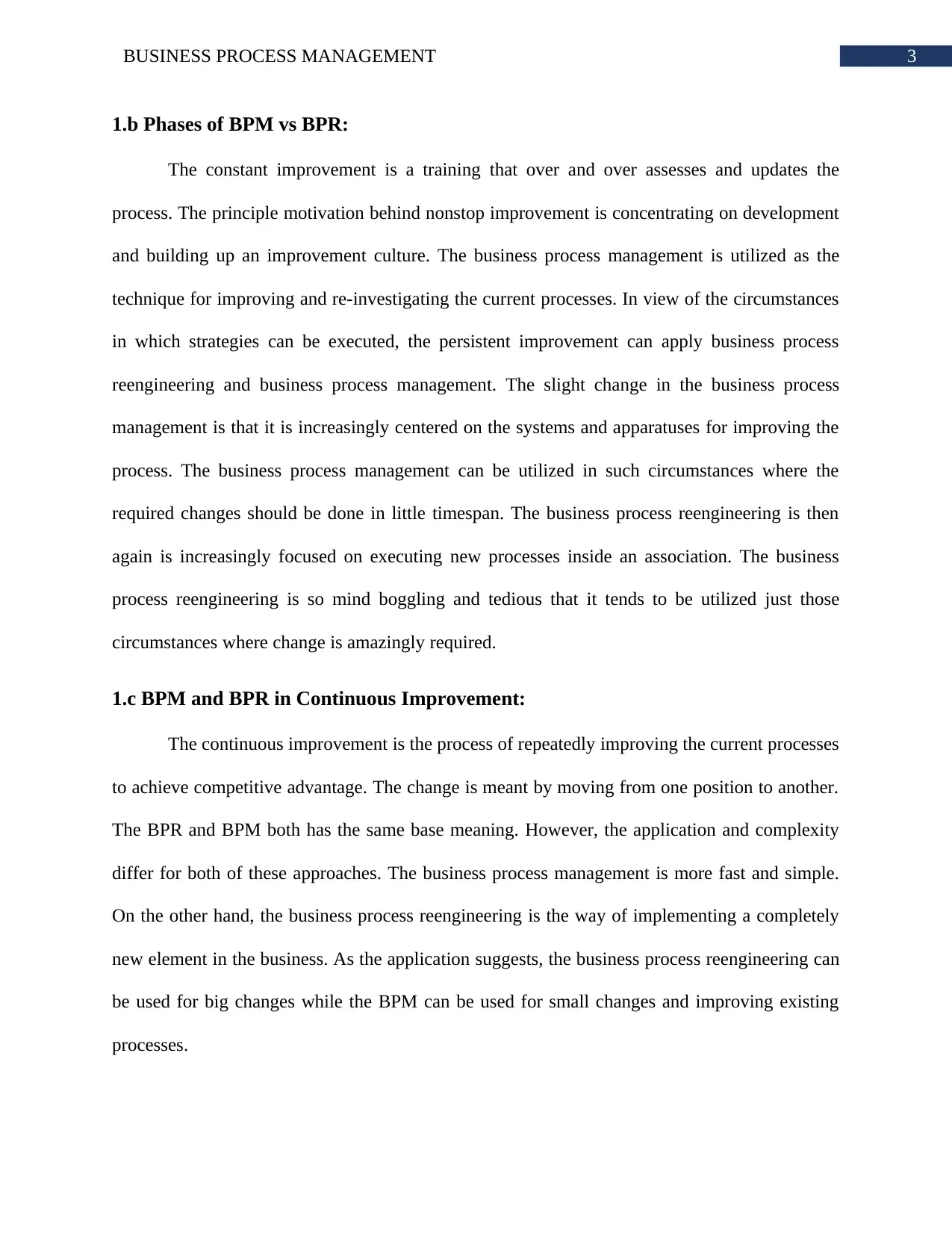
3BUSINESS PROCESS MANAGEMENT
1.b Phases of BPM vs BPR:
The constant improvement is a training that over and over assesses and updates the
process. The principle motivation behind nonstop improvement is concentrating on development
and building up an improvement culture. The business process management is utilized as the
technique for improving and re-investigating the current processes. In view of the circumstances
in which strategies can be executed, the persistent improvement can apply business process
reengineering and business process management. The slight change in the business process
management is that it is increasingly centered on the systems and apparatuses for improving the
process. The business process management can be utilized in such circumstances where the
required changes should be done in little timespan. The business process reengineering is then
again is increasingly focused on executing new processes inside an association. The business
process reengineering is so mind boggling and tedious that it tends to be utilized just those
circumstances where change is amazingly required.
1.c BPM and BPR in Continuous Improvement:
The continuous improvement is the process of repeatedly improving the current processes
to achieve competitive advantage. The change is meant by moving from one position to another.
The BPR and BPM both has the same base meaning. However, the application and complexity
differ for both of these approaches. The business process management is more fast and simple.
On the other hand, the business process reengineering is the way of implementing a completely
new element in the business. As the application suggests, the business process reengineering can
be used for big changes while the BPM can be used for small changes and improving existing
processes.
1.b Phases of BPM vs BPR:
The constant improvement is a training that over and over assesses and updates the
process. The principle motivation behind nonstop improvement is concentrating on development
and building up an improvement culture. The business process management is utilized as the
technique for improving and re-investigating the current processes. In view of the circumstances
in which strategies can be executed, the persistent improvement can apply business process
reengineering and business process management. The slight change in the business process
management is that it is increasingly centered on the systems and apparatuses for improving the
process. The business process management can be utilized in such circumstances where the
required changes should be done in little timespan. The business process reengineering is then
again is increasingly focused on executing new processes inside an association. The business
process reengineering is so mind boggling and tedious that it tends to be utilized just those
circumstances where change is amazingly required.
1.c BPM and BPR in Continuous Improvement:
The continuous improvement is the process of repeatedly improving the current processes
to achieve competitive advantage. The change is meant by moving from one position to another.
The BPR and BPM both has the same base meaning. However, the application and complexity
differ for both of these approaches. The business process management is more fast and simple.
On the other hand, the business process reengineering is the way of implementing a completely
new element in the business. As the application suggests, the business process reengineering can
be used for big changes while the BPM can be used for small changes and improving existing
processes.
Paraphrase This Document
Need a fresh take? Get an instant paraphrase of this document with our AI Paraphraser

4BUSINESS PROCESS MANAGEMENT
4.A.1 AS-IS Model:
4.A.1 AS-IS Model:
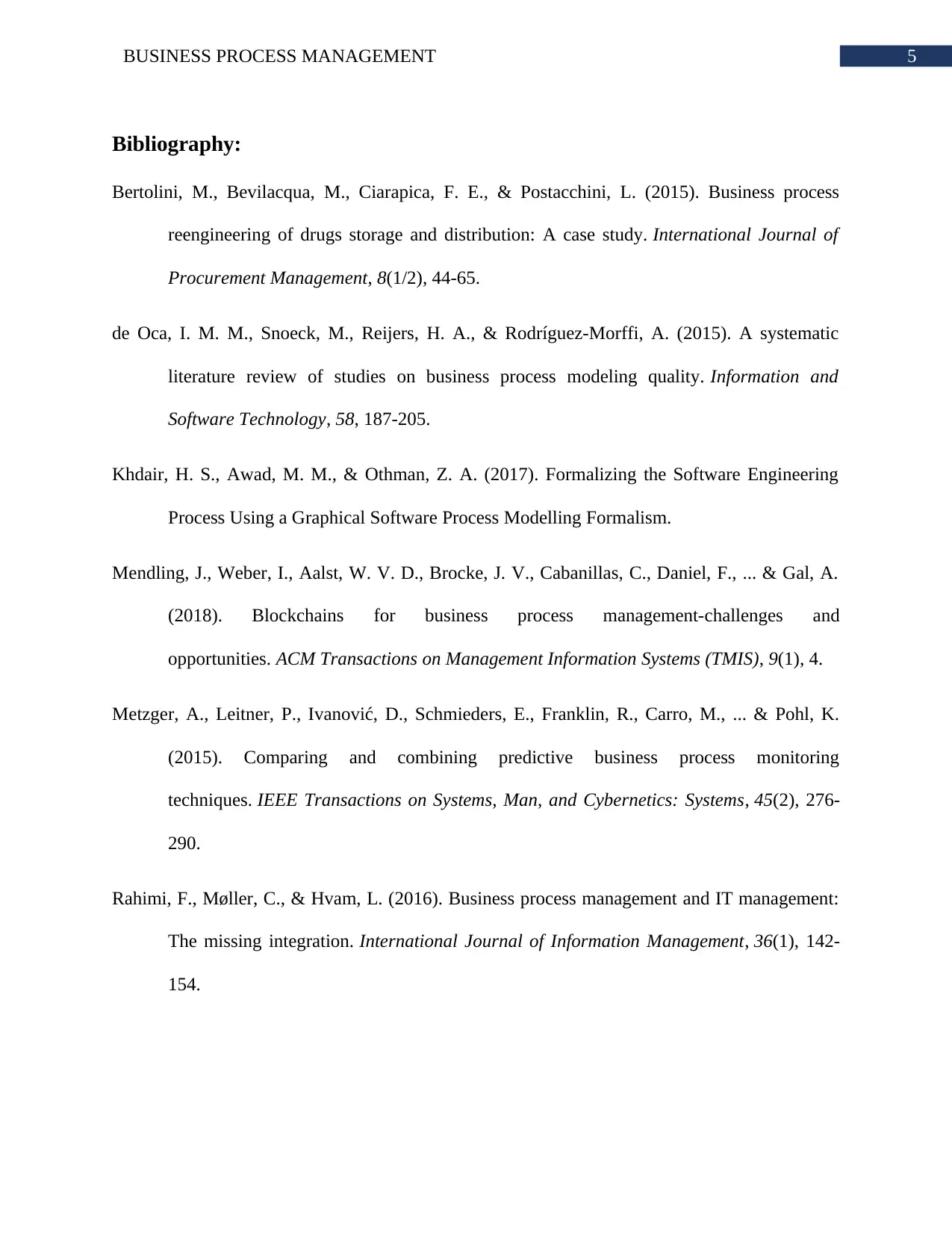
5BUSINESS PROCESS MANAGEMENT
Bibliography:
Bertolini, M., Bevilacqua, M., Ciarapica, F. E., & Postacchini, L. (2015). Business process
reengineering of drugs storage and distribution: A case study. International Journal of
Procurement Management, 8(1/2), 44-65.
de Oca, I. M. M., Snoeck, M., Reijers, H. A., & Rodríguez-Morffi, A. (2015). A systematic
literature review of studies on business process modeling quality. Information and
Software Technology, 58, 187-205.
Khdair, H. S., Awad, M. M., & Othman, Z. A. (2017). Formalizing the Software Engineering
Process Using a Graphical Software Process Modelling Formalism.
Mendling, J., Weber, I., Aalst, W. V. D., Brocke, J. V., Cabanillas, C., Daniel, F., ... & Gal, A.
(2018). Blockchains for business process management-challenges and
opportunities. ACM Transactions on Management Information Systems (TMIS), 9(1), 4.
Metzger, A., Leitner, P., Ivanović, D., Schmieders, E., Franklin, R., Carro, M., ... & Pohl, K.
(2015). Comparing and combining predictive business process monitoring
techniques. IEEE Transactions on Systems, Man, and Cybernetics: Systems, 45(2), 276-
290.
Rahimi, F., Møller, C., & Hvam, L. (2016). Business process management and IT management:
The missing integration. International Journal of Information Management, 36(1), 142-
154.
Bibliography:
Bertolini, M., Bevilacqua, M., Ciarapica, F. E., & Postacchini, L. (2015). Business process
reengineering of drugs storage and distribution: A case study. International Journal of
Procurement Management, 8(1/2), 44-65.
de Oca, I. M. M., Snoeck, M., Reijers, H. A., & Rodríguez-Morffi, A. (2015). A systematic
literature review of studies on business process modeling quality. Information and
Software Technology, 58, 187-205.
Khdair, H. S., Awad, M. M., & Othman, Z. A. (2017). Formalizing the Software Engineering
Process Using a Graphical Software Process Modelling Formalism.
Mendling, J., Weber, I., Aalst, W. V. D., Brocke, J. V., Cabanillas, C., Daniel, F., ... & Gal, A.
(2018). Blockchains for business process management-challenges and
opportunities. ACM Transactions on Management Information Systems (TMIS), 9(1), 4.
Metzger, A., Leitner, P., Ivanović, D., Schmieders, E., Franklin, R., Carro, M., ... & Pohl, K.
(2015). Comparing and combining predictive business process monitoring
techniques. IEEE Transactions on Systems, Man, and Cybernetics: Systems, 45(2), 276-
290.
Rahimi, F., Møller, C., & Hvam, L. (2016). Business process management and IT management:
The missing integration. International Journal of Information Management, 36(1), 142-
154.
⊘ This is a preview!⊘
Do you want full access?
Subscribe today to unlock all pages.

Trusted by 1+ million students worldwide
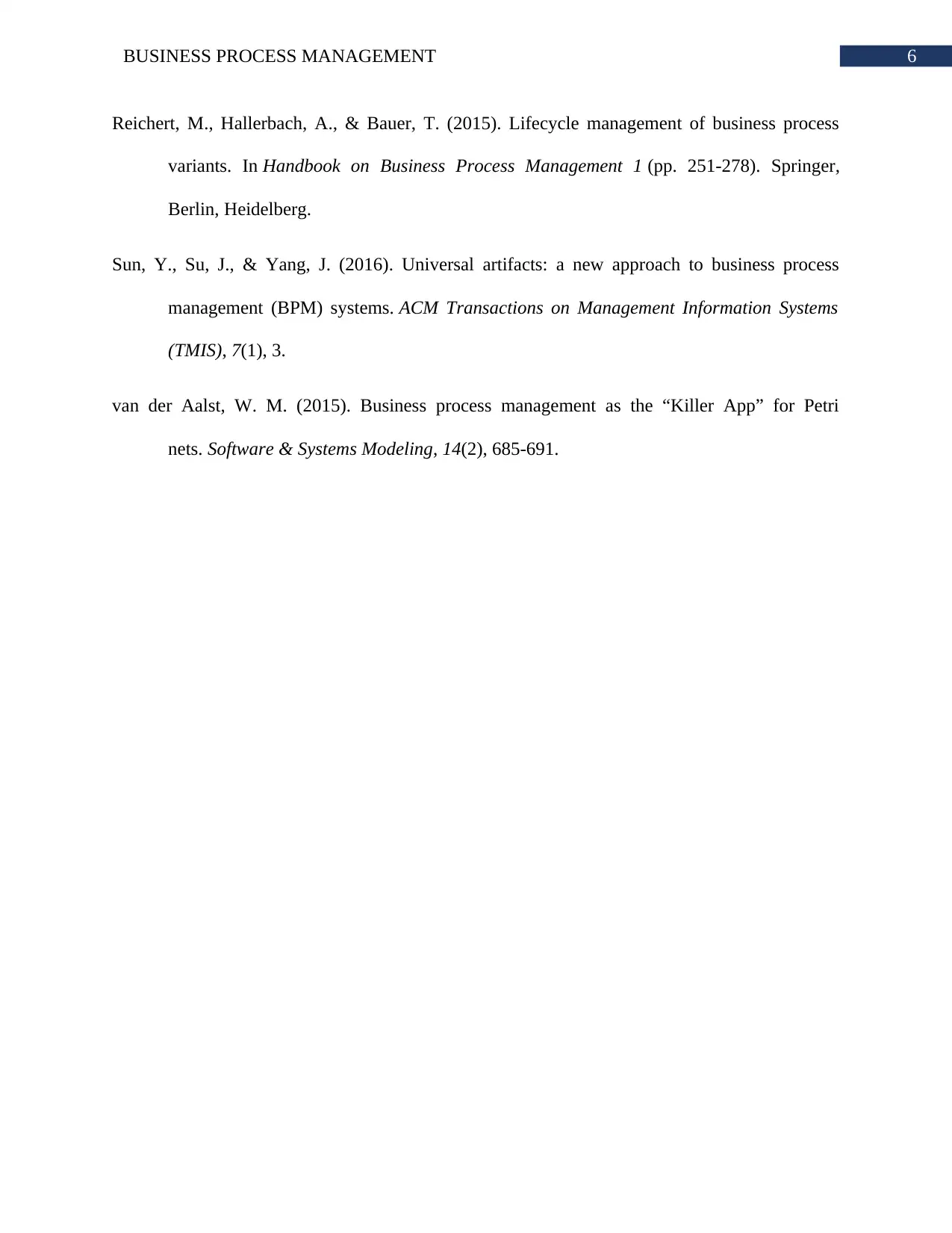
6BUSINESS PROCESS MANAGEMENT
Reichert, M., Hallerbach, A., & Bauer, T. (2015). Lifecycle management of business process
variants. In Handbook on Business Process Management 1 (pp. 251-278). Springer,
Berlin, Heidelberg.
Sun, Y., Su, J., & Yang, J. (2016). Universal artifacts: a new approach to business process
management (BPM) systems. ACM Transactions on Management Information Systems
(TMIS), 7(1), 3.
van der Aalst, W. M. (2015). Business process management as the “Killer App” for Petri
nets. Software & Systems Modeling, 14(2), 685-691.
Reichert, M., Hallerbach, A., & Bauer, T. (2015). Lifecycle management of business process
variants. In Handbook on Business Process Management 1 (pp. 251-278). Springer,
Berlin, Heidelberg.
Sun, Y., Su, J., & Yang, J. (2016). Universal artifacts: a new approach to business process
management (BPM) systems. ACM Transactions on Management Information Systems
(TMIS), 7(1), 3.
van der Aalst, W. M. (2015). Business process management as the “Killer App” for Petri
nets. Software & Systems Modeling, 14(2), 685-691.
1 out of 7
Related Documents
Your All-in-One AI-Powered Toolkit for Academic Success.
+13062052269
info@desklib.com
Available 24*7 on WhatsApp / Email
![[object Object]](/_next/static/media/star-bottom.7253800d.svg)
Unlock your academic potential
Copyright © 2020–2025 A2Z Services. All Rights Reserved. Developed and managed by ZUCOL.





